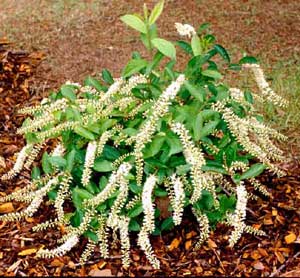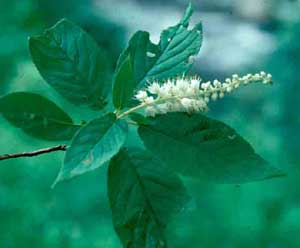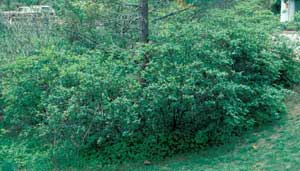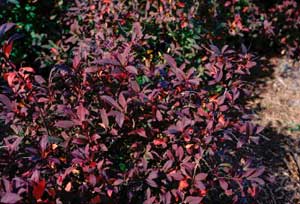Landscape Shrubs
Sweetspire, Virginia Sweetspire
(itea virginica)
Virginia sweetspire (Itea virginica) will give you a big bang for your buck—it offers multiple seasons of interest, it’s easy to grow, and it has no major pest or disease problems.
Starting in early May, showy white flowers appear and last for at least 3 weeks. The individual flowers are very small; however, they are born on arching racemes that are usually 4–7” long. While the common name sweetspire might suggest noticeably fragrant flowers, lightly fragrant seems more appropriate. Like other spring flowering shrubs, flower buds are formed on last year’s growth, so wait until after flowering to prune.
The fruit, which is a small woody capsule, is not showy. The leaf is a pleasant medium green, elliptical, with small teeth along the margin. Starting in mid-September, the green leaves will turn a rich maroon that will last until late November in most parts of the state, but through December in central Arkansas.
Itea will grow about 4’ high, and it suckers like crazy, so it will spread quickly to form a wide patch. Some of the cultivars do seem to sucker less, but we need more experience to say for sure. It is ideally suited as a medium filler shrub, as a foundation plant, in a restricted median strip, or as a naturalizing shrub. Itea could also be used as a lovely sheared low hedge. Itea is adaptable to full sun or partial shade and to wet or dry soils.
Virginia sweetspire is native in moist areas from the East Coast into eastern Arkansas (Crowley’s Ridge). Larry Lowman of Ridgecrest Nursery in Wynne, Arkansas, has introduced a selection called ‘Saturnalia’ from a plant found along the Wolf River in Tennessee. It has more orange than red during the fall.
Probably the most common cultivar being sold is ‘Henry’s Garnet.’ This superb selection from Swarthmore College has been under evaluation by the University of Arkansas since 1999. It has performed exceptionally well statewide. Other cultivars that you might find include ‘Merlot’ (supposedly more compact and may be less suckering), ‘Little Henry’ (also reported to be smaller in height, however, our observations suggest otherwise), and ‘Long Spire’ (racemes much longer, up to 10”).
Propagation would be very easy if you want to share this plant with a friend. Separate one of the rooted, underground rhizomes to make a starter plant.
- Common Name: Virginia sweetspire
- Varieties to look for: ‘Henry’s Garnet,’ ‘Saturnalia’
- Flower Color: white
- Blooming period: May
- Type: deciduous shrub
- Size: 4’ tall by 9’ wide
- Exposure: sun or partial shade
- Soil: adaptable
- Watering: moist best
- When to prune: spring
- Suggested use: mixed shrub border
Form and flowers

Flower and leaf structure

Form

Form in fall color
